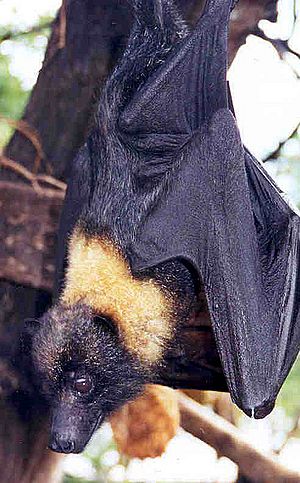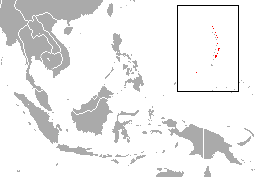Mariana fruit bat facts for kids
Quick facts for kids Mariana fruit bat |
|
|---|---|
 |
|
| Conservation status | |
| Scientific classification | |
| Genus: |
Pteropus
|
| Species: |
mariannus
|
 |
|
| Mariana fruit bat range | |
| Synonyms | |
|
Pteropus keraudren Quoy & Gaimard, 1824 |
|
The Mariana fruit bat (Pteropus mariannus) is a special type of large bat. People also call it the Mariana flying fox. In the Chamorro language, it is known as the fanihi.
You can find this bat only in the Mariana Islands and Ulithi. Ulithi is a small group of islands called an atoll in the Caroline Islands. Sadly, these bats are in danger. They are listed as an endangered species. This means their numbers are very low.
One big reason for their decline is that they are losing their homes. People are building on or changing the places where these bats live. Other threats include hunting for food. Also, other animals and natural events can harm them.
Contents
What the Mariana Fruit Bat Looks Like
The Mariana fruit bat is a medium-sized bat. It usually weighs between 0.6 and 1.1 pounds (270 to 500 grams). Its forearm, which is like its wing bone, is about 5.3 to 6.1 inches (13.4 to 15.6 cm) long.
Male bats are a little bigger than females. Their bellies can be black or brown. They also have some gray hairs mixed in. The fur around their neck and shoulders is a brighter brown or golden brown. Their heads can be brown or black.
These bats have round ears and large eyes. Because of their face shape, many large bats like this one are called "flying foxes."
Why Mariana Fruit Bats Are in Danger
One reason these bats are threatened is that some people eat them. In some cultures, like among the Chamorro people, these bats are seen as a special food.
However, eating these bats can be risky. Scientists have found that the bats sometimes eat seeds from certain plants called cycads. These seeds can have natural toxins. When the bats eat many of these seeds, the toxins can build up in their bodies. If people then eat the bats, they might get sick from these toxins.
Helping Mariana Fruit Bats
Scientists keep track of how many Mariana fruit bats there are. In 2001, there were about 300 to 400 bats on an island called Sarigan. We don't know the exact number today. But we do know there is a group of them living at Ritidian Point in Guam.
Many groups are working to protect these bats. In 2013, an organization called Bat Conservation International added the Mariana fruit bat to its list. This list includes 35 species around the world that need urgent help to survive.
How Mariana Fruit Bats Behave
Scientists have studied how these bats live and rest. On smaller islands like Sarigan, the bats often rest in smaller groups. These groups usually have about 3 to 75 bats. You can also find many bats resting alone. Sometimes, almost half of the bats on the island are by themselves.
Larger groups of bats are often made up of "harems." A harem is a group where one male bat lives with several female bats. Among the bats that rest alone, there are usually an equal number of males and females.
Types of Mariana Fruit Bats
The Mariana fruit bat has three different types, which are called subspecies:
- P. m. mariannus (This is the Guam Mariana fruit bat)
- P. m. paganensis (This is the Pagan Mariana fruit bat)
- P. m. ulthiensis (This is the Ulithi Mariana fruit bat)
See also
 In Spanish: Zorro volador de las Marianas para niños
In Spanish: Zorro volador de las Marianas para niños


